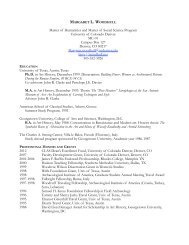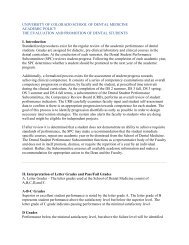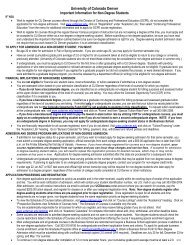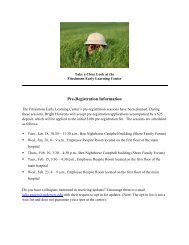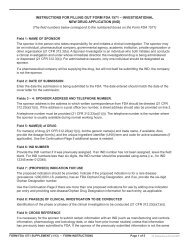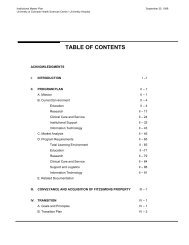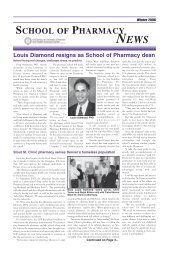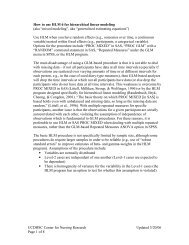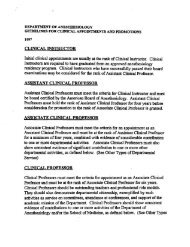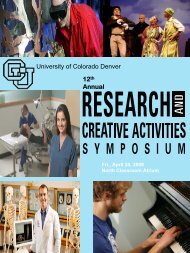Pheochromocytoma - University of Colorado Denver
Pheochromocytoma - University of Colorado Denver
Pheochromocytoma - University of Colorado Denver
Create successful ePaper yourself
Turn your PDF publications into a flip-book with our unique Google optimized e-Paper software.
<strong>Pheochromocytoma</strong><br />
Robert McIntyre, Jr., MD<br />
Pr<strong>of</strong>essor <strong>of</strong> Surgery<br />
<strong>University</strong> <strong>of</strong> <strong>Colorado</strong><br />
Nothing to Disclose<br />
Dr. McIntyre does not have any relevant<br />
commercial financial relationships to report.
<strong>Pheochromocytoma</strong><br />
• When to suspect<br />
• How to screen<br />
• How to localize<br />
• How to treat
<strong>Pheochromocytoma</strong><br />
• 2004 WHO classification <strong>of</strong> endocrine tumors<br />
• <strong>Pheochromocytoma</strong>: tumor <strong>of</strong> catecholamine<br />
producing chromaffin cells <strong>of</strong> the adrenal medulla<br />
• Tumors <strong>of</strong> extra-adrenal sympathetic and<br />
parasympathetic paraganglia are classified as<br />
paraganglioma<br />
• Parasympathetic tissue (H&N paraganglioma)<br />
rarely produce significant catecholamines
<strong>Pheochromocytoma</strong><br />
• Frequently sought, rarely found<br />
• When diagnosed and properly treated, it is<br />
curable<br />
• When undiagnosed and not properly<br />
treated it can be fatal
<strong>Pheochromocytoma</strong><br />
Prevelance<br />
• Olmsted County, MN 1-2 / 100,000<br />
• Biochemical screening 2476 people: 1.9%<br />
• Autopsy series Australia 1 / 2301<br />
• Men=Women<br />
• 3 rd to 5 th decades<br />
• Usually paroxysmal symptoms<br />
Beard et al Mayo Clin Proc 1979, Smythe et al Clin Chem 1992,<br />
McNeil et al Aust NZ J Med 2000
<strong>Pheochromocytoma</strong><br />
When to suspect<br />
• 5 “Ps” <strong>of</strong> paroxysm<br />
– Pressure - HTN<br />
– Pain - HA<br />
– Perspiration - pr<strong>of</strong>use<br />
– Palpitation<br />
– Pallor<br />
• Diverse<br />
manifestations<br />
• Variation in hormones<br />
• Variation in<br />
sensitivities<br />
• No correlation<br />
between symptoms<br />
(even HTN) and<br />
levels<br />
• Often not considered
<strong>Pheochromocytoma</strong><br />
When to suspect<br />
• HTN<br />
– Paroxysmal 50%<br />
– Persistent 30%<br />
– Normal 20%<br />
• Triad<br />
– HA, Sweating,<br />
Tachycardia in a HTN pt<br />
– Sensitivity 90.9%<br />
– Specificity 93.8%<br />
Crout et al J Clin Invest 1964
<strong>Pheochromocytoma</strong><br />
When to screen<br />
• Hyperadrenergic spells<br />
• Resistant HTN<br />
• Familial disorder (MEN2, VHL, SDH, NF-I)<br />
• Family History<br />
• Incidentaloma<br />
• Pressor response to anesthesia<br />
• HTN < 20 years old<br />
• Dilated cardiomyopathy
Genetics<br />
5 genes<br />
• MEN 2: Ret proto-oncogene (RET)<br />
• Von Hippel-Lindau (VHL)<br />
• Neur<strong>of</strong>ibromatosis type I (NF I)<br />
• Succinate dehydrogenase<br />
– Subunits D (SDHD) and B (SHDB)<br />
• SDHC<br />
– Parasympathetic paragangliomas
Frequency <strong>of</strong> Genetic Mutations<br />
Nonfamilial<br />
Country<br />
Germany and<br />
Gene (%)<br />
Poland<br />
Holland France Spain<br />
VHL 11 4.4 3.5 6<br />
SDHB 4 1.5 7 10<br />
SDHD 4 1.6 0.8 10<br />
RET 5 0 0.4 1<br />
23 7.5 11.5 27<br />
Neumann et al New Eng J Med 2002<br />
Amar et al J Clin Oncol 2005<br />
Pacak et al Nat Clin Pract Endocrinol Metab 2007
First International Symposium<br />
on <strong>Pheochromocytoma</strong><br />
• There is now a reasonable argument for<br />
more widespread genetic testing,<br />
• It is neither appropriate nor currently costeffective<br />
to test for every disease-causing<br />
gene in every patient with a<br />
pheochromocytoma or paraganglioma<br />
• The decision to test, and which genes to<br />
test, requires judicious consideration <strong>of</strong><br />
numerous factors<br />
First International Symposium on <strong>Pheochromocytoma</strong> (ISP)<br />
2005, Bethesda, MD, USA
Algorithm for genetic testing for genes<br />
associated with pheochromocytoma<br />
First International Symposium on <strong>Pheochromocytoma</strong> (ISP)<br />
2005, Bethesda, MD, USA
<strong>Pheochromocytoma</strong><br />
When to screen<br />
Suspicion<br />
High<br />
Low<br />
Low<br />
Pretest Probability<br />
Incidentaloma<br />
High HU<br />
Incidentaloma<br />
Low HU<br />
Symptoms<br />
Pallor spells<br />
New HTN<br />
Flushing Spells<br />
High
Which Test?<br />
• Institutional bias<br />
• Catecholamines can be metabolized within<br />
chromaffin cells and released as<br />
metanephrines (or normetanephrines)<br />
independently <strong>of</strong> catecholamines which<br />
can occur at low rates
• Fractionated<br />
metanephrines<br />
– Urine (conjugated)<br />
– or plasma (free)<br />
– or both (lab expertise)<br />
– No consensus<br />
Which Test?<br />
• Not rely on binary<br />
testing<br />
– Continuous result<br />
– Trade <strong>of</strong>f sensitivity<br />
and specificity<br />
Pacak et al Nat Clin Pract Endocrinol Metab 2007
<strong>Pheochromocytoma</strong><br />
Mayo Clinic test stratification<br />
• 24 – hr urine metanephrines & catecholamines<br />
– Sensitivity 98% (sporadic) 90% (inc syndromic)<br />
– Specificity 98%<br />
Sporadic<br />
• Fractionated plasma free metanephrines<br />
– Sensitivity 97-100% (inc syndromic)<br />
– Specificity 85-89%<br />
Syndromic<br />
Total met > 1000 mcg<br />
Nmet > 900 mcg, Met > 400 mcg<br />
& or > 2x normal NE, Epi, Dopa<br />
Kudva et al JCEM 2003<br />
Perry et al Clin Endocrinol 2007<br />
Sawka et al JCEM 2003<br />
Lenders et al JAMA 2002
<strong>Pheochromocytoma</strong><br />
Mayo Clinic test stratification<br />
• 24 hr urine<br />
– Sporadic<br />
– Low probability<br />
symptoms<br />
– Older HTN pts<br />
• Plasma free<br />
metanephrines<br />
– Unable to get 24 hr<br />
urine<br />
– 24 hr urine<br />
inconclusive<br />
– High suspicion:<br />
• PHx/FHx<br />
• MEN, VHL, SDH, NF-I<br />
Kudva et al JCEM 2003
<strong>Pheochromocytoma</strong><br />
False positive<br />
• Tricyclic antidepressants<br />
• Levodopa<br />
• Ethanol<br />
• Withdrawl (esp clonidine)<br />
• Antiphsychotics<br />
• Major stress<br />
• Sleep apnea
<strong>Pheochromocytoma</strong><br />
Pathophysiology Traditional View<br />
• Circulating catecholamines<br />
• Sympathetic nervous system normal or<br />
depressed<br />
Pacak JCEM 2007
<strong>Pheochromocytoma</strong><br />
Pathophysiology<br />
• However, blood pressure does not<br />
correlate with circulating catecholamines<br />
• BP can be normal with high catechol<br />
levels<br />
• SNS intact<br />
• Clonidine is effective despite maintaining<br />
high circulating levels
<strong>Pheochromocytoma</strong><br />
Pathophysiology<br />
Chlorisondamine Bretylium<br />
Johnson et al J Pharm Exp Ther 1983
<strong>Pheochromocytoma</strong><br />
Pathophysiology<br />
Sympathetic Nerve Impulse<br />
Johnson et al J Pharm Exp Ther 1983
Pathophysiology<br />
Control (early) Pheo (early) Control (late) Pheo (late)<br />
Intact anesthetized rats<br />
SBP 106+-5 175+-10* 116+-4 202+-15*δ<br />
DBP 67+-4 93+-9* 70+-3 127+-11*δ<br />
HR<br />
Pithed rats<br />
337+-7 470+-12* 345+-5 510+-13*<br />
SBP 68+-4 114+-5* 73+-2 115+-8*<br />
DBP 41+-2 42+-2 43+-2 50+-2*δ<br />
HR 330+-5 466+-7* 336+-6 506+-14*<br />
Pithed rats (after phentolamine)<br />
SBP 67+-2 70+-3 68+-2 74+-4<br />
DBP 40+-2 31+-1* 42+-2 34+-2*<br />
HR 328+-12 448+-17 330+-10 487+-19<br />
Tsujimoto et al Circ Res 1987
<strong>Pheochromocytoma</strong><br />
Pathophysiology<br />
• Loading <strong>of</strong> sympathetic<br />
vesicles with catecholamine<br />
• Increase sympathetic<br />
neuronal impulse frequency<br />
• Selective desensitization <strong>of</strong><br />
presynaptic α2 adrenergic<br />
receptors which inhibit<br />
release <strong>of</strong> NE<br />
Langer et al Hypertension 1980
<strong>Pheochromocytoma</strong><br />
Pathophysiology<br />
• Direct or reflexive stimuli <strong>of</strong> SNS activity<br />
releases excessive NE stores causing<br />
hypertensive crisis.
<strong>Pheochromocytoma</strong><br />
Pathophysiology<br />
• Other mediators<br />
– Neuropeptide Y<br />
• Indirect cardiovascular effects = potentiates NE<br />
action<br />
• Direct effects = vasoconstriction, resistant to α<br />
blockade
<strong>Pheochromocytoma</strong><br />
Pathophysiology<br />
• Catecholamines may be high or low and<br />
BP does not correlate<br />
• SNS hyper-reactive leading to spells<br />
• Other mediators
Surgical Endocrinology<br />
• Never do a localization study before a<br />
biochemical diagnosis
<strong>Pheochromocytoma</strong><br />
Localization<br />
• Adrenal and abdominal imaging (MRI = or<br />
> CTS, institutional bias) is first test<br />
• Paragangliomas<br />
– Superior abdominal para-aortic (46%)<br />
– Inferior abdominal para-aortic (39%)<br />
– Bladder (10%)<br />
– Thorax (10%)<br />
– H & N (3%)<br />
– Pelvis (2%)<br />
Whalen et al J Urol 1992; Erickson et al 2001
<strong>Pheochromocytoma</strong><br />
Localization<br />
• Unilateral adrenal pheochromocytoma<br />
– No need for I 123 MIBG<br />
• Paraganglioma<br />
– I 123 MIBG<br />
• Negative abdominal imaging<br />
– H&N and chest imaging<br />
– I 123 MIBG<br />
• SRS Indium 111 pentreotide<br />
• FDG-PET
<strong>Pheochromocytoma</strong><br />
Algorithm<br />
Young Rev Endo Metab Disord 2007
<strong>Pheochromocytoma</strong><br />
Preoperative Blockade<br />
• Manage hypertension<br />
• Control cardiac symptoms<br />
• Decrease perioperative morbidity and<br />
mortality<br />
• Phenoxybenzamine – nonspecific α<br />
blockade<br />
• Hypertensive crisis occur with or without α<br />
blockade
<strong>Pheochromocytoma</strong><br />
Preoperative Preparation<br />
• 113 patients Cleveland Clinic 1977 to<br />
1994<br />
• 92 adrenal and 21 extra-adrenal tumors<br />
• 12 syndromic<br />
• Saline expansion 3 hours before surgery<br />
Urlacher et al J Urol 1999
<strong>Pheochromocytoma</strong><br />
Preoperative Preparation<br />
Preoperative<br />
antihypertensive<br />
medications<br />
Overall % 1990-1994 %<br />
Ca channel blockade 26 45<br />
Selective α blockade* 30 20<br />
β blockers** 20 18<br />
Phenoxybenzamine 10 5<br />
No medications 30 30<br />
*(prazosin, doxazosin, terazosin)<br />
Urlacher et al J Urol 1999
<strong>Pheochromocytoma</strong><br />
Preparation v No preparation<br />
No Medications Medications p Value<br />
Systolic max. (mm. Hg) 198 192 0.40<br />
Systolic min. (mm. Hg) 99 102 0.39<br />
Diastolic max. (mm. Hg) 104 106 0.62<br />
Diastolic min. (mm. Hg) 56 58 0.45<br />
Intraop. fluids (cc) 5,536 6,492 0.08<br />
Postop. day 1 fluids (cc) 3,387 3,866 0.05<br />
Urlacher et al J Urol 1999
<strong>Pheochromocytoma</strong>:<br />
State <strong>of</strong> the Art<br />
• These studies suggest that the need for the use<br />
<strong>of</strong> POB or other drugs that produce pr<strong>of</strong>ound<br />
and long-lasting -blockade in preparing<br />
pheochromocytoma patients for the surgical<br />
removal <strong>of</strong> the tumor is no longer necessary.<br />
• This is, in large part, attributable to advances in<br />
anesthetic and monitoring techniques and the<br />
availability <strong>of</strong> fast-acting drugs capable <strong>of</strong><br />
correcting sudden changes in cardiovascular<br />
hemodynamics.<br />
Bravo and Tagle JCEM 2003
<strong>Pheochromocytoma</strong><br />
Preoperative Blockade<br />
• First International Symposium on<br />
<strong>Pheochromocytoma</strong><br />
– all patients should receive appropriate preoperative<br />
medical management to block the effects <strong>of</strong> released<br />
catecholamines<br />
– Wide-ranging practices, international differences in<br />
available or approved therapies, and a scarcity <strong>of</strong><br />
evidence-based studies comparing different therapies<br />
leads to a lack <strong>of</strong> consensus regarding the<br />
recommended drugs for preoperative blockade.<br />
Pacak et al Nat Clin Pract Endocrinol Metab 2007
<strong>Pheochromocytoma</strong><br />
Preoperative Blockade<br />
• α-adrenoceptor antagonists, calcium channel<br />
blockers, or angiotensin receptor blockers<br />
• For tachyarrhythmias, ß-adrenoceptor or calcium<br />
channel blockers.<br />
• ß-adrenoceptor blockers should be used only<br />
after adequate pretreatment with α-adrenoceptor<br />
antagonists to avoid hypertensive crisis from<br />
unopposed α-adrenoceptor overstimulation.<br />
Pacak et al Nat Clin Pract Endocrinol Metab 2007
<strong>Pheochromocytoma</strong><br />
Preoperative Preparation<br />
• 105 patients 1991 2002 at Lille's <strong>University</strong><br />
Hospital<br />
• Oral nicardipine (20–60 mg.day−1 as TID).<br />
Preparation 3 days in normotensive vs 7-<br />
10 days in others<br />
• 1 hour preop oral dose 20 mg<br />
• OR: infusion <strong>of</strong> nicardipine at 0.5–<br />
2.0 μg.kg−1 .min−1 Lebuffe et al Anaesthesia 2005
Peri-operative complications<br />
Transient hypertension 65 (61.9)<br />
SBP > 160 mmHg 65 (61.9)<br />
SBP > 180 mmHg 47 (44.8)<br />
SBP > 200 mmHg 27 (25.7)<br />
SBP > 220 mmHg 14 (13.3)<br />
Persistent hypertension 4 (3.8)<br />
Tachycardia event 30 (28.5)<br />
Sustained hypotension 13 (12.4)<br />
Death 2 (1.9)<br />
Postoperative complications 9.5%<br />
Myocardial infarction 3 (2.8)<br />
Pulmonary embolism 1 (0.9)<br />
Prolonged mechanical ventilation 3 (2.8)<br />
Non septic hyperthermia 3 (2.8)<br />
Death 1 (0.9)<br />
ICU; days Median (range) 1 (0–7)<br />
Hosp LOS Median (range) 10 (2–35)<br />
Lebuffe et al Anaesthesia 2005
<strong>Pheochromocytoma</strong><br />
Hemodynamic Instability during Surgery<br />
73 patients Erasmus Medical Center 1995-2007<br />
Pretreatment α blockade (PXB or DOX)<br />
48 <strong>of</strong> 73 (66%) MAP < 100 mm Hg<br />
39 <strong>of</strong> 48 (81%) BP < 130/85 mm Hg<br />
25 <strong>of</strong> 73 (34%) MAP >100 mm Hg<br />
Adequate BP achieved 55% (PXB) and 53%<br />
(DOX) <strong>of</strong> patients<br />
Bruynzeel et al JCEM 2010
<strong>Pheochromocytoma</strong><br />
Hemodynamic Instability during Surgery<br />
Intraoperative time SBP above 160 mm Hg<br />
MAP response to blockade<br />
plasma norepinephrine levels (r = 0.23; P < 0.05),<br />
tumor diameter (r = 0.36; P < 0.01),<br />
postural BP fall (r = 0.30; P < 0.05)<br />
Bruynzeel et al JCEM 2010
<strong>Pheochromocytoma</strong><br />
Hemodynamic Instability during Surgery<br />
• Postoperative MAP was significantly higher PXB vs DOX<br />
(P < 0.01).<br />
• No relation between the PXB or DOX dosage and<br />
intraoperative BP fluctuations or postoperative<br />
hypotension.<br />
• The doses <strong>of</strong> esmolol (25 patients) were significantly<br />
higher in the PXB group compared with the DOX group<br />
(314.5 mg, 25.0–5520; vs. 95.0 mg, 0.06–2500 mg; P <<br />
0.05).<br />
• Other vasoactive drugs as phenylephrine (n = 15),<br />
nitroglycerine (n = 24), NE (n = 36), and phentolamine (n<br />
= 28) did not differ between both groups.<br />
Bruynzeel et al JCEM 2010
Comparison <strong>of</strong> Two Preoperative<br />
Strategies<br />
• Retrospective chart review <strong>of</strong> 50 Mayo<br />
Clinic patients and 37 Cleveland Clinic<br />
patients<br />
• Mayo Clinic predominantly used the longlasting<br />
nonselective α1,2 antagonist<br />
phenoxybenzamine, and Cleveland Clinic<br />
predominately used selective α1 blockade.<br />
Weingarten et al Urology 2010
Comparison <strong>of</strong> Two<br />
PreoperativeStrategies<br />
% Mayo Clinic (50) Cleveland Clinic (37)<br />
Phenoxybenzamine 98 16<br />
β blockade 78 46<br />
CCB 22 30<br />
α 1 Adrenergic<br />
blockade<br />
2 65<br />
Metyrosine 6 0<br />
Oral NaCl 60 89<br />
IV Hydration 8 0<br />
Weingarten et al Urology 2010
Characteristic Mayo Clinic (50) Cleveland Clinic (37) P Value<br />
Anesthetic (min) 201 ± 43 306 ± 185
Hemodynamics Mayo Clinic (50) Cleveland Clinic (37) P Value<br />
Greatest BP fs<br />
Systolic BP 187 ± 30 209 ± 44 .011<br />
Mean BP 136 ± 20 151 ± 30 .004<br />
Diastolic BP 109 ± 18 114 ± 26 .294<br />
Systolic BP ≥30%<br />
baseline (min)<br />
Systolic BP ≥200<br />
mm Hg (min)<br />
Lowest BP (mm Hg)<br />
2 (0–11) 5 (0–22) .119<br />
0 (0–2) 0 (0–7) .071<br />
Systolic BP 73 ± 14 78 ± 15 .159<br />
Mean BP 55 ± 11 56 ± 10 .870<br />
Diastolic BP 46 ± 9 43 ± 9 .191<br />
Systolic BP ≤ 30%<br />
baseline, min<br />
Systolic BP ≤30%<br />
baseline (%<br />
anesthesia time)<br />
28 (6–62) 13 (3–49) .114<br />
15.7 (3.3–24.9) 5.1 (0.9–16.0) .026
Comparison <strong>of</strong> Two<br />
PreoperativeStrategies<br />
% Mayo Clinic<br />
(50)<br />
Cleveland Clinic<br />
(37)<br />
P value<br />
EBL (mL) 75 (25–150) 100 (82–250) .010<br />
Intraoperative<br />
crystalloid (L)<br />
Intraoperative<br />
colloid (L)<br />
3.0 (2.0–3.1) 5.0 (3.4–6.4)
Comparison <strong>of</strong> Two Preoperative<br />
Strategies<br />
• Noncompetitive -adrenergic antagonist<br />
phenoxybenzamine appeared to produce<br />
better attenuation <strong>of</strong> intraoperative<br />
hypertension<br />
• But at the cost <strong>of</strong> longer lasting<br />
intraoperative hypotension that required a<br />
greater use <strong>of</strong> vasopressors.<br />
Weingarten et al Urology 2010
• Open anterior<br />
• Thoraco-abdominal<br />
• Flank<br />
• Posterior<br />
• Laparoscopic<br />
• Retroperitoneoscopic<br />
Adrenalectomy
Open v Laparoscopy<br />
PRT <strong>University</strong> <strong>of</strong> Brescia<br />
Pts with hypertensive<br />
peaks<br />
Open Laparoscopic<br />
3/9 6/13 n.s.<br />
Hypertensive peaks/pts 1.8 2.2 n.s.<br />
Blood loss, cc 164 ± 94 48 ± 36
Open v Laparoscopy<br />
Mt Sinai New York<br />
Parameter Laparoscopic (11) Open(11) P<br />
Intraoperative<br />
Hypertension<br />
11 8 NS<br />
Intraoperative<br />
Hypotension<br />
4 6 NS<br />
Duration 146 + 36 153+55 NS<br />
LOS 5.5+2.2 6.1+1.6 NS<br />
Complications 0 1 NS<br />
Inabnet et al W J Surg 2000
• Type<br />
• Size<br />
• Site<br />
• Hereditary<br />
Surgical Technique<br />
•Adrenal cortex sparing<br />
•Prevent permanent glucocorticoid deficiency<br />
•Risk <strong>of</strong> tumor recurrence
Pathology<br />
• 2004 WHO defines malignancy as<br />
metastasis not invasion<br />
• Invasion is poor predictor <strong>of</strong> metastasis<br />
• Lack <strong>of</strong> invasion does not preclude<br />
metastasis<br />
• Several scoring systems<br />
• No consensus
• Extra-adrenal<br />
• Course nodularity<br />
• Confluent necrosis<br />
• Hyaline globules<br />
• Size<br />
Pathology<br />
Linnoila et al Hum Pathol 1990<br />
Thompson et al Am J Surg Pathol 2002<br />
Kimura et al Endocr Pathol 2005
<strong>Pheochromocytoma</strong> <strong>of</strong> the Adrenal<br />
Gland Scaled Score (PASS)<br />
•PASS <strong>of</strong> >=4 correctly<br />
identified all tumors that were<br />
histologically malignant,<br />
•17 <strong>of</strong> the 50 patients did not<br />
develop malignant clinical<br />
behavior.<br />
•All <strong>of</strong> the patients who had<br />
clinically aggressive<br />
neoplasms were identified by<br />
a PASS <strong>of</strong> >=4.<br />
Sensitive<br />
but not specific<br />
Thompson et al Am J Surg Pathol 2002
Immunohistochemistry<br />
nuclear pleomorphism<br />
Ki67 immunohistochemistry<br />
Spindle cell<br />
Kimura et al Endocr Pathol 2005
Risk <strong>of</strong> Recurrence<br />
Hôpital Européen Georges Pompidou, Paris, France<br />
1975-2003<br />
29/176 at risk = 16% over 9 years<br />
Amar et al JCEM 2005
Hazard ratios for the risk <strong>of</strong> recurrence<br />
Coefficient SE P value<br />
Hazard<br />
ratio<br />
95%<br />
Confidence<br />
interval<br />
Age, per yr –0.008 0.015 0.602 0.992 0.963–1.022<br />
Familial vs.<br />
sporadic<br />
1.235 0.523 0.018 3.437 1.234–9.584<br />
Bilateral vs. left<br />
adrenal<br />
0.351 1.152 0.760 1.421 0.149–13.58<br />
Right vs. left<br />
adrenal<br />
1.127 0.760 0.138 3.085 0.696–13.69<br />
Extraadrenal<br />
vs. left adrenal<br />
2.420 0.828 0.003 11.24 2.219–56.99<br />
Tumor<br />
diameter, per<br />
cm<br />
0.140 0.058 0.015 1.150 1.027–1.289<br />
Amar et al JCEM 2005
• No consensus<br />
• Yearly<br />
Follow up testing
Metastatic <strong>Pheochromocytoma</strong><br />
• Options limited, no cure<br />
• Debulking palliates symptoms but no<br />
survival advantage<br />
• RFA lesions<br />
• EBRT: bone metastasis
Metastatic <strong>Pheochromocytoma</strong><br />
• Chemotherapy: cyclophosphamide,<br />
vincristin, dacarbazine (CVD)<br />
– 50% tumor shrinkage = improved symptoms<br />
– Short lived, no survival advantage<br />
• I 131 Labeled MIBG<br />
Huang et al Cancer 2008<br />
47%<br />
64%<br />
Gonias et al J Clin Onc 2009
Targeted Therapies<br />
• Vascular endothelial<br />
growth factor (VEGF),<br />
• Endothelin receptor<br />
type A and B,<br />
• Telomerase complex,<br />
• Heat shock protein 90<br />
(HSP90)<br />
• Cyclo-oxygenase and<br />
• N-cadherin<br />
• VEGF-inhibitor<br />
– thalidomide with<br />
temozolomide<br />
• Tyrosine kinase<br />
inhibitors<br />
– Sunitinib<br />
– Sorafenib<br />
– Imatinib mesylate<br />
• mTOR<br />
– Everolimus
• Distinct<br />
– Phenotypes<br />
– Neurochemistry<br />
– Histopathology<br />
Future Direction<br />
Eisenh<strong>of</strong>er et al Endocrine-Related Cancer 2004
Chris Raeburn<br />
Proteomic Hypothesis:<br />
• Distinct phenotypic pr<strong>of</strong>iles <strong>of</strong> patients with<br />
pheochromocytoma derive from distinct<br />
pathogenesis due to protein expression<br />
• Distinct tumors arise from different cell origins
Questions?




